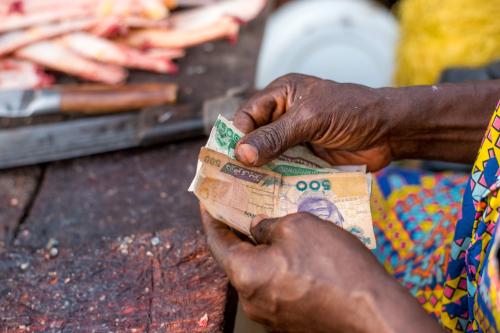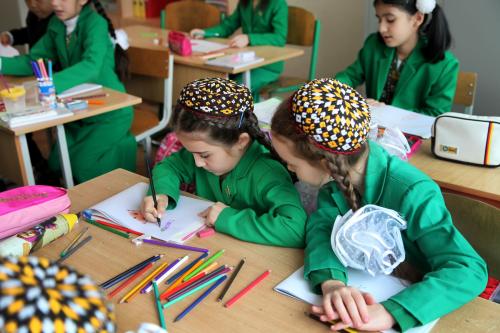In recent years, China’s economic presence in Africa has led to a heated debate, some of it well-informed and some of it not, about the nature of Chinese involvement and its implications for the continent. The debate is partially motivated by the rapid growth of China’s economic presence in Africa: for example, Chinese investment in Africa grew from USD 210 million in 2000 to 3.17 billion in 2011.[1] Aid is an important policy instrument for China among its various engagements with Africa, and indeed Africa has been a top recipient of Chinese aid: by the end of 2009 it had received 45.7 percent of the RMB 256.29 billion cumulative foreign aid of China.[2] This aid to Africa has raised many questions, such as its composition, its goal and nature.
What constitutes China’s aid?
Officially, China provides eight types of foreign aid: complete projects, goods and materials, technical cooperation, human resource development cooperation, medical assistance, emergency humanitarian aid, volunteer programs, and debt relief. [3] China’s aid to Africa covers a wide array of fields, such as agriculture, education, transportation, energy, communications, and health. According to Chinese scholars, since 1956, China has provided almost 900 aid projects to African countries, including assistance supporting textile factories, hydropower stations, stadiums, hospitals, and schools.
Official development assistance is defined by the Organisation for Economic Co-operation and Development (OECD) as concessional funding given to developing countries and to multilateral institutions primarily for the purpose of promoting welfare and economic development in the recipient country. [4] China is not a member of OECD and does not follow its definition or practice on development aid. The bulk of Chinese financing in Africa falls under the category of development finance, but not aid. This fact is privately acknowledged by Chinese government analysts, although Chinese literature constantly blurs the distinction between the two categories.
The billions of dollars that China commits to Africa are repayable, long-term loans. From 2009 to 2012, China provided USD 10 billion in financing to Africa in the form of “concessional loans.”[5] During Chinese President Xi Jinping’s first overseas trip to Africa in March 2013, he doubled this commitment to USD 20 billion from 2013 to 2015.[6] The head sovereign risk analyst of Export-Import Bank of China announced in November 2013 that by 2025, China will have provided Africa with USD 1 trillion in financing, including direct investment, soft loans and commercial loans. [7]
China’s own policy actively contributes to the confusion between development finance and aid. The Chinese government encourages its agencies and commercial entities to “closely mix and combine foreign aid, direct investment, service contracts, labor cooperation, foreign trade and export.”[8] The goal is to maximize feasibility and flexibility of Chinese projects to meet local realities in the recipient country, but it also makes it difficult to capture which portion of the financing is – or should be – categorized as aid. One rather convincing theory is that the Chinese government in effect pays for the difference between the interest rates of concessional loans provided to Africa and comparable commercial loans. Therefore, only the small difference in interest rates could qualify as Chinese aid.
Who does China’s aid serve?
Despite Chinese leaders’ claim that China’s assistance to Africa is totally selfless and altruistic, the reality is far more complex.[9] China’s policy toward Africa is pragmatic, and aid has been a useful policy instrument since the early days of People’s Republic of China.
During the Cold War, foreign aid an important political tool that China used to gain Africa’s diplomatic recognition and to compete with the United States and the Soviet Union for Africa’s support. Between 1963 and 1964, Zhou Enlai visited 10 African countries and announced the well-known “Eight Principles of Foreign Economic and Technological Assistance.”[10] These aid principles were designed to compete simultaneously with the “imperialists” (the United States) and the “revisionists” (the Soviet Union) for Africa’s approval and support.
These efforts were enhanced during the Cultural Revolution under the influence of a radical revolutionary ideology, motivating China to provide large amounts of foreign aid to Africa despite its own domestic economic difficulties. [11] One famous example was the Tanzania-Zambia Railway built between 1970 and 1975, for which China provided a zero-interest loan of RMB 980 million. By the mid-1980s, China’s generous assistance had opened the door to diplomatic recognition with 44 African countries. [12]
Since the beginning of China’s reform and opening up, especially after 2000, Africa has become an increasingly important economic partner for China. Africa enjoys rich natural resources and market potential, and urgently needs infrastructure and development finance to stimulate economic growth. Chinese development finance, combined with the aid, aims at not only benefiting the local recipient countries, but also China itself. For example, China’s “tied aid” for infrastructure usually favors Chinese companies (especially state-owned enterprises), while its loans are in many cases backed by African natural resources.
Much Chinese financing to Africa is associated with securing the continent’s natural resources. Using what is sometimes characterized as the “Angola Model,” Chinas frequently provides low-interest loans to nations who rely on commodities, such as oil or mineral resources, as collateral.[13] In these cases, the recipient nations usually suffer from low credit ratings and have great difficulty obtaining funding from the international financial market; China makes financing relatively available—with certain conditions.
Though commodity-backed loans were not created by China – leading Western banks were making such loans to African countries, including Angola and Ghana, before China Eximbank and Angola completed their first oil-backed loan in March 2004 – but the Chinese built the model to scale and applied it using a systematic approach. In Angola in 2006, USD 4 billion in such loans probably helped Chinese oil companies win the exploitation rights to multiple oil blocks.[14] In 2010, Sinopec’s acquisition of a 50 percent stake in Block 18 coincided with the disbursement of the first tranche of Eximbank funding, and in 2005, Sinopec’s acquisition of rights to Block 3/80 coincided with the announcement of a new USD 2 billion loan from China Eximbank to the Angolan government.[15] In 2008, the China Railway Group used the same model to secure the mining rights to the Democratic Republic of Congo’s copper and cobalt mines under the slogan “(Infrastructure) projects for resources.”[16] According to Debra Brautigam, a top expert on China-Africa relations, between 2004 and 2011, China reached similar unprecedented deals with at least seven resource-rich African countries, with a total volume of nearly USD 14 billion.[17]
In addition to securing Africa’s natural resources, China’s capital flows into Africa also create business opportunities for Chinese service contractors, such as construction companies. According to Chinese analysts, Africa is China’s second-largest supplier of service contracts, and “when we provide Africa assistance of RMB 1 billion, we will get service contracts worth USD 1 billion (RMB 6 billion) from Africa.”[18] In exchange for most Chinese financial aid to Africa, Beijing requires that infrastructure construction and other contracts favor Chinese service providers: 70 percent of them go to “approved,” mostly state-owned, Chinese companies, and the rest are open to local firms, many of which are also joint ventures with Chinese groups.[19] In this sense, China’s financing to Africa, including aid, creates business for Chinese companies and employment opportunities for Chinese laborers, a critical goal of Beijing’s Going Out strategy.
How to understand Chinese aid to Africa?
With a few exceptions, there is a strong tendency among observers to assert moral judgments in the assessment of Chinese aid and development finance to Africa: China’s activities are either “evil” because they represent China’s selfish quest for natural resources and damage Africa’s fragile efforts to improve governance and build a sustainable future; or they are “virtuous” because they contribute to a foundation for long-term economic development, through infrastructure projects and revenue creation.
This polarization reveals the two sides of the same coin. On the positive side, China’s aid and development financing fills a void left by the West and promotes the development of African countries. Many Chinese projects require large investment and long pay-back terms that traditional donors are reluctant to provide. On the other hand, however, these short-term benefits should not form a cover-up for the potential long-term negative consequences associated with neglecting issues of governance, fairness and sustainability. For example, when the “tied aid” is linked to the profitability of Chinese companies, it becomes questionable whether China would prioritize Africa’s interests or its own.
There is also an ongoing debate inside China about the goal and management of Chinese aid to Africa. For the foreign policy bureaucrats at the Ministry of Foreign Affairs, foreign aid is essentially a political instrument for China to strengthen bilateral ties and facilitate the development of African countries. In their view, political considerations should be the most important criteria in aid decision-making. Economic benefits associated with aid projects, such as profitability, resource extraction, or the acquisition service contracts for Chinese vendors, should only be secondary.
However, trade promoters such as the Ministry of Commerce have rather opposite perspective. In their view, foreign aid serves China’s overall national priority, which by definition is economic growth. Therefore, all aspects of aid decisions should reflect broad economic considerations. Under this logic, the inclination is to allocate the aid budget to countries that offer China the greatest number of commercial opportunities and benefits. Since China’s top economic interest is Africa’s natural resources, aid decisions are inevitably skewed toward resource-rich countries while others receive less favorable consideration.[20]
This practice is problematic in that many of the resource-rich African countries with which China works also suffer from serious political problems, such as authoritarianism, poor governance, and corruption. When the Ministry of Commerce pursues economic gains and associates aid projects with resource extraction, it uses aid packages to promote business relations. This directly contributes to the negative perception that China is pouring aid, funding, and infrastructure projects to prop up corrupt governments in exchange for natural resources. As many Chinese analysts observe, the Foreign Ministry in recent years has been fighting fiercely for the authority to manage China’s foreign aid projects, which are currently under the purview of the Ministry of Commerce.
The intention of China’s aid to Africa is benign but not altruistic. China does not seek to use aid to influence the domestic politics of African countries or dictate policies. Instead, it truly hopes to help Africa achieve better development while avoiding meddling with the internal affairs of African countries through conditional aid. But on the other hand, China is not helping Africa in exchange for nothing. Chinese projects create access to Africa’s natural resources and local markets, business opportunities for Chinese companies and employment for Chinese labors. When Chinese officials emphasize that China also provides aid to countries that are not rich in natural resources to defuse international criticisms, they often forget to mention that China may have its eyes on other things which these countries can deliver, such as their support of Beijing’s “one China” policy, of China’s agenda at multilateral forums, and of China as a “responsible stakeholder.” In this sense, China’s comprehensive, multi-dimensional agenda of its aid to Africa defies any simplistic categorization.
[1] “Report on Development of China’s Outward Investment and Economic Cooperation, 2011-2012,” [中国对外投资合作发展报告], Ministry of Commerce, December 2012.
[2] He Wenping, “China to Africa: Gives It Fish and Teaches It Fishing,” [中国对非洲:授其以鱼,更授其以渔], JinRongBaoLan, May 6, 2013, http://finance.sina.com.cn/money/bank/bank_hydt/20130506/200915363934.shtml.
[3] “China’s Foreign Aid,” Xinhua News Agency, April 21, 2011, http://news.xinhuanet.com/english2010/china/2011-04/21/c_13839683_6.htm.
[4] “Official Development Assistance: Definition and Coverage,” OECD, http://www.oecd.org/dac/stats/officialdevelopmentassistancedefinitionandcoverage.htm.
[5] “China To Complete 10 Billion USD Concessional Loans to Africa before the End of Year,” [中国将在年底前完成对非洲100亿美元优惠贷款计划], China Radio International, July 20, 2012. http://gb.cri.cn/27824/2012/07/20/3365s3778295.htm
[6] “China to Provide 20 billion USD Loan Credits to Africa in Three Years,” [中国三年内将向非洲提供200亿美元贷款额度], Cai Xin, March 25, 2013, http://international.caixin.com/2013-03-25/100506116.html.
[7] Toh Han Shih, “China to Provide Africa with US$1 trillion financing,” November 18, 2013, South China Morning Post, http://www.scmp.com/business/banking-finance/article/1358902/china-provide-africa-us1tr-financing.
[8] Piao Yingji, “The Evolution and Future Trend of China’s Direct Investment in Africa,” 《中国对非洲直接投资的发展历程与未来趋势》, [Hai Wai Tou Zi Yu Chu Kou Xin Dai], 2006 Volume 5. www.eximbank.gov.cn/topic/hwtz/2006/1_19.doc.
[9] “Wen Jiabao: China Did Not Exploit One Single Drop of Oil or One Single Ton of Minerals from Africa,” China.com.cn, September 15, 2011, http://www.china.com.cn/economic/txt/2011-09/15/content_23419056.htm.
[10] The principles include: China always bases itself on the principle of equality and mutual benefit in providing aid to other nations; China never attaches any conditions or asks for any privileges; China helps lighten the burden of recipient countries as much as possible; China aims at helping recipient countries to gradually achieve self-reliance and independent development; China strives to develop aid projects that require less investment but yield quicker results; China provides the best-quality equipment and materials of its own manufacture; in providing technical assistance, China shall see to it that the personnel of the recipient country fully master such techniques; the Chinese experts are not allowed to make any special demands or enjoy any special amenities. “Zhou Enlai Announced Eight Principles of Foreign Aid,” China Daily, August 13, 2010.
[11] “African Expert Interprets the 55 Years of Sino-African Relations,” 《非洲专家解读中非关系55年》, China Talk, Feb 23, 2011, fangtan.china.com.cn/2011-02/21/content_21965753.htm.
[12] Ibid.
[13] Yi Yimin, “China Probes Its Africa Model,” China Dialogue, August 18, 2011, http://www.chinadialogue.net/article/show/single/en/4470-China-probes-its-Africa-model-1-.
[14] Zhang Changbing, “Opportunities and Challenges in Exploring and Developing African Oil Resources,” [勘探开发非洲石油资源的机遇与挑战], Guo Ji Jing Ji He Zuo, 2008, Volume 3, http://waas.cass.cn/upload/2011/06/d20110619154331656.pdf.
[15] Lucy Corkin, “China and Angola: Strategic Partnership or Marriage of Convenience?”, The Angola Brief, January 2011, Volume 1, No.1 http://www.cmi.no/publications/publication/?3938=china-and-angola-strategic-partnership-or-marriage.
[16] “Projects for Resources, China Railway Heads for DRC to Develop Cobalt Mines,” [以项目换资源 中国中铁赴刚果(金)开发铜钴矿], Zhong Guo Zheng Quan Bao, April 23, 2008, http://ccnews.people.com.cn/GB/7153049.html.
[17] Debra Brautigam, “China: Africa’s Oriental Hope,” [中国:非洲的东方希望], Hai Wai Wen Zhai, August 25, 2011, http://www.observe-china.com/article/51.
[18] Yang Fei, “People Should Rationally Understand the USD 20 Billion Assistance Loans to Africa,” [对“200亿美元援非贷款”应理性看待], China Radio International, March 29, 2013, http://gb.cri.cn/27824/2013/03/29/2165s4069180.htm.
[19] Jamil, Anderlini, “China Insists on ‘Tied Aid’ to Africa,” Financial Times, June 25, 2007, http://www.ft.com/cms/s/0/908c24f2-2343-11dc-9e7e-000b5df10621.html#axzz2RtN8dPxR.
[20] Interview with a Chinese analyst, Beijing, March 2013.
The Brookings Institution is committed to quality, independence, and impact.
We are supported by a diverse array of funders. In line with our values and policies, each Brookings publication represents the sole views of its author(s).



Commentary
Op-edChina’s Aid to Africa: Monster or Messiah?
February 7, 2014